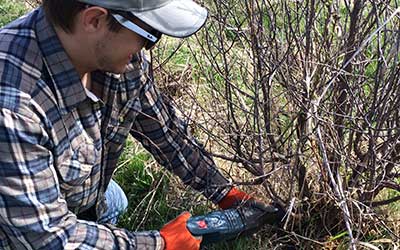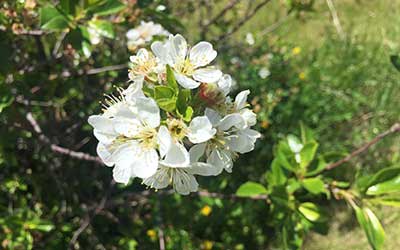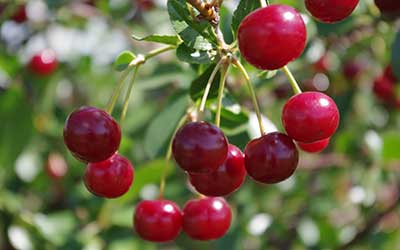-
Traditional Sour Cherries 11-16
-
Romance Cherries 20+


Cherry Education
Giving you a Taste of what it's all About

Whether you call them tart or sour, learn a little more about the cherries you have already come to love and remember our cherries are -
A little bit TART with a whole lot of SWEET!
Developing the Romance
WHere it All Started
The University of Saskatchewan (U of S) has the most northern program in North America for breeding hardy fruit for our harsh climatic zones.
Dwarf Cherry Development
Dwarf cherries have been in development since the 1940’s and the first, Carmine Jewel, was released for propagation in 1999. In 2004, Romeo, Juliet, Valentine, Cupid and Crimson Passion were released as the Romance Series.

A Hybrid For OUr Environment
The Romance Series of cherries are crosses of Mongolian Sour cherries and Sour cherries from Northern Europe. The hybrids have the fruit size of sour cherries and the hardiness and dwarfing qualities of Mongolian cherries. They are hardy and can grow in the extreme prairie climate that discourages pests and disease. Most growers use few or no chemicals in orchard management practices.
The University’s website is a great place to find more information https://research-groups.usask.ca/fruit/Fruit%20crops/sour-cherries.php

Sourcing the Romance Series
The University of Saskatchewan licenses propagation. Each plant is cloned and is identical to the original plant, allowing all cherries to grow and ripen in the same period.
Every year more nurseries and garden centres are stocking University of Saskatchewan Romance Cherries. Check with your local retailers for availability, as well as online or seed catalogues.
For a list of commercial companies that sell plants you can also visit https://research-groups.usask.ca/fruit/buying-our-plants/buyingourplants.php
Harvesting the Taste

The longer the cherries are allowed to remain on the bush, the deeper the colour and the sweeter they taste. Carmine Jewel is the first to ripen at the end of July. Cupid, the largest cherry, is about 4 weeks behind, deeply coloured and sweet at the end of August and into September. The other varieties are available for two to three weeks each during this period. Click here to find out more about the different varieties (add a link to the brochure here). Our Growers page can help you find out where to get fresh cherries and cherry products.

Cherries should be picked early in the morning when it is cool and kept out of direct sunlight. Use shallow containers to prevent squishing and refrigerate as quickly as possible. They can be stored unwashed, loosely covered for 2 to 4 days. The softer the cherry, the shorter the storing period.
Using the Bounty

Retaining Colour, Sweetness and Flavour
While sweet cherries are best eaten fresh in season, they lose much of their flavour when heated. Sour cherries retain their colour, sweetness, and flavour through the cooking process.
Taste and See - Visit our Recipes page for Great Tasting Ideas!
Brix Level
The level of naturally occurring sugar in fruit can be measured as a brix level. Traditional sour cherries can have a brix ranging from 11 to 16, while the Romance cherries rival sweet cherries and have levels of 20 or more. As a result they require less added sugar for cooking than other tart cherries.

Colour and Antioxidant Levels
The dark burgundy colouring throughout the Romance cherries eliminates the need for the added food dye in processing required by varieties that have yellow flesh. Health research has linked the dark red colour to high antioxidant levels.




